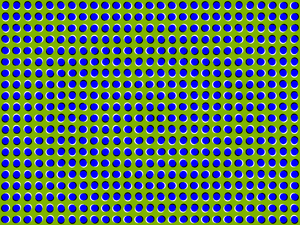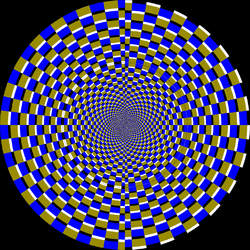Peripheral drift illusion

The peripheral drift illusion (PDI) refers to a motion illusion generated by the presentation of a sawtooth luminance grating in the visual periphery. This illusion was first described by Faubert and Herbert (1999), although a similar effect called the "escalator illusion" was reported by Fraser and Wilcox (1979). A variant of the PDI was created by Kitaoka Akiyoshi and Ashida (2003) who took the continuous sawtooth luminance change, and reversed the intermediate greys. Kitaoka has created numerous variants of the PDI, and one called "rotating snakes" has become very popular. The latter demonstration has kindled great interest in the PDI.
The illusion is easily seen when fixating off to the side, and then blinking as fast as possible. Most observers see the illusion easily when reading text (such as this article) with the illusion figure in the periphery. Motion is consistently perceived in a dark-to-light direction, so the two circles to the right should spin in opposite directions.
Two papers have been published examining the neural mechanisms involved in seeing the PDI (Backus & Oruç, 2005; Conway et al., 2005). Faubert and Herbert (1999) suggested the illusion was based on temporal differences in luminance processing producing a signal that tricks the motion system. Both of the articles from 2005 are broadly consistent with those ideas, although contrast appears to be an important factor (Backus & Oruç, 2005).
-

Illusion similar to Rotating Snakes by Kitaoka Akiyoshi
-

A peripheral drift illusion by Paul Nasca
-

A peripheral drift illusion by Paul Nasca
References
- Faubert, J. & Herbert, A.M. (1999). The peripheral drift illusion: A motion illusion in the visual periphery. Perception, 28, 617–622.
- Fraser, A., Wilcox, K.J. (1979). Perception of illusory movement. Nature, 281, 565–566.
- Kitaoka. A., Ashida. H. (2003). Phenomenal characteristics of the peripheral drift illusion. Vision, 15, 261–262.
- Backus, B.T. & Oruç, İ. (2005). Illusory motion from change over time in the response to contrast and luminance. Journal of Vision, 5(11), 1055–1069, , doi:10.1167/5.11.10.
- Conway, B.R., Kitaoka, A., Yazdanbakhsh, A., Pack, C.C., Livingstone, M.S. (2005). Neural basis for a powerful static motion illusion. Journal of Neuroscience, 25, 5651–5656.
External links
- Rotating snakes at Akiyoshi's illusion pages
- Rotating rings at Sarcone's optical illusion pattern page
- These patterns move, but it’s an illusion by Smithsonian Research Lab